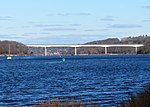Poquetanuck, Connecticut
AC with 0 elementsHistoric districts in New London County, ConnecticutHistoric districts on the National Register of Historic Places in ConnecticutNRHP infobox with nocatNational Register of Historic Places in New London County, Connecticut ... and 3 more
Preston, ConnecticutVillages in ConnecticutVillages in New London County, Connecticut

Poquetanuck is a village in the town of Preston, Connecticut, located near the banks of a bay known as Poquetanuck Cove that opens to the Thames River. The village includes the National Register of Historic Places (NRHP)-listed Poquetanuck Village Historic District.
Excerpt from the Wikipedia article Poquetanuck, Connecticut (License: CC BY-SA 3.0, Authors, Images).Poquetanuck, Connecticut
Poquetanuck Road,
Geographical coordinates (GPS) Address Nearby Places Show on map
Geographical coordinates (GPS)
| Latitude | Longitude |
|---|---|
| N 41.487222222222 ° | E -72.041944444444 ° |
Address
Poquetanuck Road 134
06365
Connecticut, United States
Open on Google Maps









